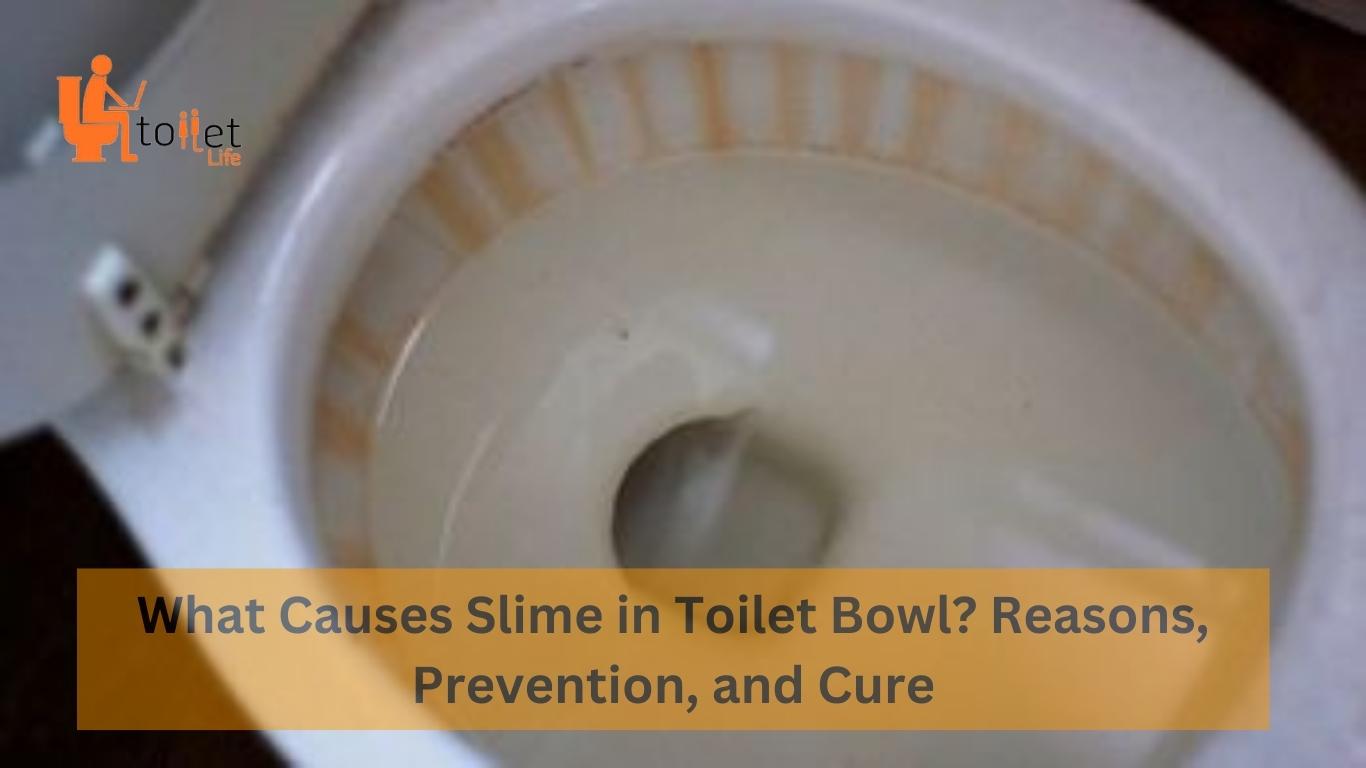Have you noticed slime or red-brown substance in the toilet bowl or water tank at the back of your toilet? Are you looking for easy and effective solutions? and want to know What Causes Slime in Toilet Bowl?
Don’t worry! We have your back. No matter how carefully you use the toilet – you can not keep your bathroom clean and free from gunk if you do not know the reason behind the slimy problem.
So, what causes slime in the toilet bowl? The main reason is — iron bacteria. If you want to know more about the reasons, prevention, and cure of slime buildup, stick to the end!
Read: How to Remove Black Plunger Marks From the Toilet Bowl?
What Causes Slime and Similar Gunks in a Toilet Bowl?

Mainly, oxidizing bacteria cause slimy strands and similar-looking sticky substances. The most common is iron bacteria and sulfur bacteria. There are other similar bacteria that create slimes. If you notice pink rings, a Serratia bacteria might have caused it.
How or why does it actually happen? Iron bacteria are commonly found in well and groundwater sources. They use dissolved iron or manganese present in the water to grow. Mild temperatures and low-level of dissolved oxygen help in the growth.
The bacteria produce by-products, such as slime, debris, rust, etc., while growing. Sometimes, iron and sulfur bacteria can coexist in private water systems. This makes the slimy problem even worse! In such a case, you will face heavy slimes in the water tank, toilet bowls, and other similar places.
Read: Can You Use Toilet Bowl Cleaner in Kitchen Sink?
Are Slimes Harmful?
Every time you lift the lid of the toilet or tank, you will definitely not like to be introduced to a sticky, reddish arrangement. Apart from that, slime-forming bacteria can cause an unpleasant taste in water. Additionally, you will face a few common problems like extreme water discoloration, corrosion of plumbing, pungent odor, clogging of the water system, etc. Slimes are the by-product of iron/sulfur bacteria. Slimes often leave permanent stains on the toilet bowl.
So, we can say, slimes might be really off-putting. They can create the above-mentioned issues as well. But they will not cause you any health hazards.
Read: Can Toilet Bowl Cleaner Kill A Dog?
How Can You Detect Slime-Forming Bacteria?

If you notice reddish, brown, yellowish, orange or gray-colored slimy strands inside the toilet bowl or toilet tank – this is the first sign. It indicates that your water source might have slime-forming bacteria/iron bacteria.
For a second thought, you can notice the taste and odor present in the water. Do you notice smells similar to swampy, rotten vegetation, rotten egg, sewage, or cucumbers? There might be iron bacteria. To detect the odor effectively, leave the water unused for several hours.
Another culprit in forming slimes is sulfur bacteria. To detect the presence of sulfur bacteria, look for rotten-egg odor. Sulfur bacteria produce hydrogen sulfide gas in hot water. The gas smells like rotten eggs. These bacteria produce dark-colored slimes.
If you have a magnesium rod in the water system, make sure to replace it with an aluminum or zinc rod. Then check for the rotten-egg odor. Why? Because an anti-corrosion magnesium rod causes a chemical reaction in contact with hot water. The chemical reaction often produces hydrogen sulfide gas. So, change the rod to get the correct result.
The last and final step – test the water of your water sources for the presence of iron and manganese. A few labs specifically test for iron and sulfur bacteria. You can get that test done too. This way, you can detect the presence of slime-forming bacteria correctly.
Read: How To Raise Water Level In Toto Toilet Bowl?
How Can You Prevent Slime-Forming Bacteria?

It is easier to prevent iron and sulfur bacteria from forming in your water system than to treat them. It gets extremely difficult to get rid of them once they form and start growing in water.
These bacteria usually contaminate the water during the construction and maintenance of the water sources. So, hiring professionals for drilling, installing, plumbing, and other services related to your private water system would be safe. Make sure they consider sanitary practices and sanitize the equipment during the process.
Additionally, you can shock chlorinate the water source after construction. Various maintenance procedures often expose the water source to contamination threats. You should also shock chlorinate in such cases.
Also Read: Can You Put Oxiclean in Toilet Bowl?
How Can You Treat Slime-Forming Bacteria?

There are several ways to treat slime-forming bacteria and prevent their growth.
Here are a few common ways of treating slimy problems:
Disinfect with shock chlorination
Shock chlorination is a process to disinfect private water systems. It is an inexpensive and straightforward procedure. Owners often use this process to disinfect wells, springs, tanks, etc.
You can follow the procedure by adding a large amount of chlorine to the water source. Then pumping the water out through the distribution system.
The method is often the first disinfection method people often try. It helps to control the growth of the bacteria. But this method will not entirely remove slime-forming bacteria from your water system. It is safe to use this method every six months. Frequent use of this method can cause damage to the water system.
Read: How to Remove Toilet Bowl Ring
Disinfect with disinfectant products
You can use any disinfectant toilet cleaning product with chlorine/bleach formula. Chlorine works effectively to eliminate slime-forming bacteria. Damp the toilet bowl and inside of the toilet tank, and apply the cleaner to targeted areas. Let the product sit there for over an hour. Then scrub the areas with a toilet brush and rinse off with clean water.
You can follow this method twice weekly to prevent bacteria from growing and keep the slimes away. Make sure the toilet areas are exposed to enough light and air. It will prevent the growth of the bacteria to some extent.
Also Read: How to Raise Water Level in Toilet Bowl
How Can You Remove Brown Stains From The Toilet Bowl?

Slimes can leave stubborn stains in your toilet bowl. But getting rid of the brown stains is easier than getting rid of the slime itself. Add 1 cup of white vinegar and 1-2 cups of lemon juice. Apply the mixture to the stained areas. Let it sit for a couple of minutes. Then scrub the surfaces with a brush. Finally, rinse off with clean water.
You can also soak a few toilet paper in vinegar and lemon juice. Then stuff them inside the toilet rim. Leave it there for a couple of hours. They will dissolve the mineral buildup. Then scrub the areas with a toilet brush using toilet cleaner. Then flush.
To remove stains from the toilet tank, firstly, empty the tank. Then fill it with a gallon of vinegar. Leave it for a couple of hours. Then flush the tank and fill it with clean water.
Have you noticed slime or red-brown substance in the toilet bowl or water tank at the back of your toilet? Are you looking for easy and effective solutions?
Don’t worry! We have your back. No matter how carefully you use the toilet – you can not keep your bathroom clean and free from gunk if you do not know the reason behind the slimy problem.
So, what causes slime in the toilet bowl? The main reason is — iron bacteria. If you want to know more about the reasons, prevention, and cure of slime buildup, stick to the end!
Related Post:
How to Remove Black Plunger Marks From the Toilet Bowl?










